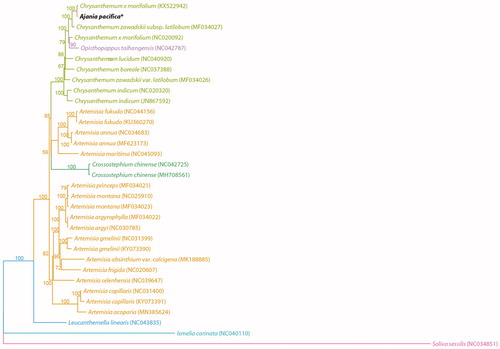Abstract
The complete chloroplast (cp) genome sequence of Ajania pacifica, called as golden and silver chrysanthemum, was newly analyzed in this study. It was 151,059 bp in length and was a typical circular structure composed of and comprised of a large single copy region (82,857 bp) and a small single copy region (18,294 bp) which were separated by two inverted repeat regions (24,954 bp). The molecular phylogenetic analyses of A. pacifica and its related taxa was conducted based on the complete chloroplast genome sequences, and it was proved that the genus Ajania is embedded in the genus Chrysanthemum clade as well as a monotypic genus Opisthopappus. In the other hand, the genus Artemisia was divided into two group in the tribe Anthemideae.
The Genus Ajania Poljakov is a member of daisy family. It belongs to the subfamily Asteroideae Lindley and the tribe Anthemideae Cass. within the family Asteraceae Berchtold & J. Presl (Oberprieler et al. Citation2007; Chase et al. Citation2016). The tribe Anthemideae is largely divided into two groups of Artemisia-group and Chrysanthemum-group even the debates on generic circumscription (Zhao et al. Citation2010; Liu et al. Citation2012), and Ajania is included in the latter group. Depend on the movement of the position, the genus Ajania had been included in the Chrysanthemum sensu lato or recognized a member of Dendranthema (DC.) Des Moul. before it was recently defined as an independent genera based on the feature of just disciform without ray floret. It is comprised of about 35–39 species and distributed in the temperate Asia, especially in China and Japan (Kadereit and Jeffrey Citation2007; Ajania at Flora of China website, http://www.efloras.org/florataxon.aspx?flora_id=2&taxon_id=100912). Among them, A. pacifica (Nakai) K. Bremer & Humphries is an endemic to Honshu of Japan and generally distributed along in the pacific coast (Ohashi and Yonekura Citation2004). But it has been introduced and cultivated in Korea recently.
We collected the plant material which was planted in the garden of Korea National Arboretum (37° 45.241′N, 127° 09.828′E, alt. 114 M) and the voucher (2019–1663) was deposited at the Herbarium of Chungbuk National University (CBNU). Complete chloroplast genome of Ajania pacifica (MN883841) was sequenced by HiSeq4000 of Illumina. Totally 31,846,800 paired-end reads (2 × 151bp) were obtained and 27,440,456 reads were used for the assemble to the reference sequence after trimming with the length range 50–151 bp. The assembled reads were de novo assembled using the Geneious assembler. Using the assembled contigs, we conducted to align and repeat the procedure up to make a single contig. Complete chloroplast genome was annotated using Geneious 10.2.6 (Kearse et al. Citation2012) with manual correction and tRNAScan-SE (Lowe and Eddy Citation1997) for tRNA gene. The average coverage of this chloroplast genome was 250.9. The phylogenetic tree was constructed with related Asteraceae members based on the concatenated 78 coding genes using RAxML (Stamatakis Citation2014).
The complete chloroplast genome of Ajania pacifica has a typical circular structure with 151,059 bp in length and comprised a large single copy region (LSC, 82,857 bp), a small single copy region (SSC, 18,294 bp), and two inverted repeat regions (IR, 24,954 bp). The GC contents was 37.5%. It was composed of 135 genes and they were identified 87 coding genes, 8 rRNA genes, and 37 tRNA genes. From the result of molecular phylogenetic analysis based on the complete chloroplast genome sequences, it was proved that the genus Ajania was embedded in the Chrysanthemum clade with strong support as well as monotypic genus Opisthopappus C. Shih (). Besides, the genus Artemisia L. was apparently divided into two groups and Crossostephium Less. was a sister to one of them in the tribe Anthemideae. The relationship between Ajania and Chrysanthemum is one of the issue which has been studied by many researchers because of their distinguishable characteristics but confused phylogeny. The present data supported the closer relationship between them despite of morphological difference.
Disclosure statement
No potential conflict of interest was reported by the author(s).
Additional information
Funding
References
- Chase MW, Christenhusz MJM, Fay MF, Byng JW, Judd WS, Soltis DE, Mabberley DJ, Sennikov AN, Soltis PS, Stevens PF, et al. 2016. An update of the Angiosperm Phylogeny Group classification for the orders and families of flowering plants: APG IV. Bot J Lin Soc. 181:1–20.
- Kadereit JW, Jeffrey C. 2007. The families and genera of vascular plants. In: Kubitzki K, editor. Flowering Plants. Eudicots: Asterales. Vol. VIII. Berlin Heidelberg: Springer-Verlag; p. 357.
- Kearse M, Moir R, Wilson A, Stone-Havas S, Cheung M, Sturrock S, Buxton S, Cooper A, Markowitz S, Duran C, et al. 2012. Geneious Basic: an integrated and extendable desktop software platform for the organization and analysis of sequence data. Bioinformatics. 28(12):1647–1649.
- Liu PL, Wan Q, Guo YP, Yang J, Rao GY. 2012. Phylogeny of the genus Chrysanthemum L.: evidence from single-copy nuclear gene and chloroplast DNA sequences. PLoS One. 7(11):e48970.
- Lowe TM, Eddy SR. 1997. tRNAscan-SE: A program for improved detection of transfer RNA genes in genomic sequence. Nucl Acids Res. 25(5):955–964.
- Oberprieler C, Himmelreich S, Vogt R. 2007. A new subtribal classification of the tribe Anthemideae (Compositae). Willdenowia. 37(1):89–114.
- Ohashi H, Yonekura k. 2004. New combinations in Chrysanthemum (Compositae-Anthemideae) of Asia with a list of Japanese species. J Jpn Bot. 79(3):186–195.
- Stamatakis A. 2014. RAxML version 8: a tool for phylogenetic analysis and post-analysis of large phylogenies. Bioinformatics. 30(9):1312–1313.
- Zhao H-B, Chen F-D, Chen S-M, Wu G-S, Guo W-M. 2010. Molecular phylogeny of Chrysanthemum, Ajania and its allies (Anthemideae, Asteraceae) as inferred from nuclear ribosomal ITS and chloroplast trnL-F IGS sequences. Plant Syst Evol. 284(3–4):153–169.

